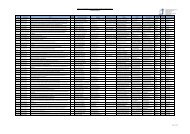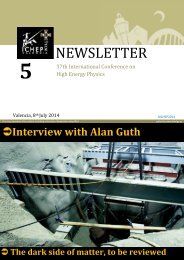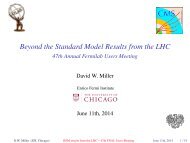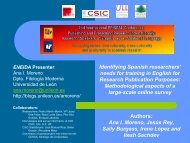PW_mar13_sample_issue
PW_mar13_sample_issue
PW_mar13_sample_issue
Create successful ePaper yourself
Turn your PDF publications into a flip-book with our unique Google optimized e-Paper software.
Quantum frontiers: Weak measurement<br />
Weak insights into interference<br />
In the famous Bohr–Einstein debates, the fact that an interference pattern in<br />
a double-slit experiment disappears if you measure which slit the particle goes<br />
through was explained in terms of the uncertainty principle. Measuring the particle<br />
disturbs its momentum, the argument went, which washes out the interference.<br />
However, from a modern perspective, information is fundamental and what<br />
destroys the interference is knowing which slit the photon goes through – in other<br />
words, the presence of “which-path” information. In the 1990s there was a rather<br />
heated debate over whether or not a which-path measurement could be carried<br />
out without disturbing the momentum (see, for instance, Nature 351 111 and<br />
367 626). However, in 2003 Howard Wiseman at Griffith University in Brisbane<br />
came up with a proposal to observe what really happens when a measurement<br />
is performed to tell which slit the photon traverses (Phys. Lett. A 311 285) – an<br />
experiment that our group at the University of Toronto performed for real in 2007<br />
using the principle of weak measurement. We were able to directly measure<br />
the momentum disturbance by making a weak measurement of each photon’s<br />
momentum at early times, and then measuring strongly what its momentum was<br />
at the end of the experiment – the difference between the two values being the<br />
average momentum change, roughly speaking (New J. Phys. 9 287).<br />
In the original 1990s debate, the two camps had chosen very different<br />
definitions of momentum transfer, leading each to prove seemingly contradictory<br />
conclusions about its magnitude. Our experiment, by following Wiseman’s<br />
proposal of weak measurement as an operational definition, was thus introducing<br />
a third notion of momentum transfer. Remarkably, the result of this experiment<br />
agreed with the most important aspects of both original proofs, in some sense<br />
resolving the controversy. Even though the different groups chose different<br />
definitions, one cannot help but think that all these definitions reveal part<br />
of a bigger story about what is really “going on” – otherwise, why should a<br />
measurement carried out using one definition satisfy theorems proved for two<br />
entirely unrelated definitions? This is just one of the open questions that those<br />
who deal with weak measurements find so fascinating.<br />
40<br />
according to Heisenberg’s formula ΔxΔp ≥ /2, where<br />
is Planck’s constant divided by 2p. But as Masanao<br />
Ozawa from Tohoku University in Japan showed in<br />
2003, it is also possible to calculate the minimum<br />
disturbance that a measurement must impart (Phys.<br />
Rev. A 67 042105). As expected, Ozawa found that<br />
the more precise a measurement the more it must<br />
disturb the quantum particle. Surprisingly, however,<br />
the detailed values predicted by his result said that<br />
it should be possible to make a measurement with<br />
less disturbance than predicted by (inappropriately)<br />
applying Heisenberg’s formula to the problem of<br />
measurement disturbance.<br />
At first, it seemed unclear whether one could conceive<br />
of an experimental test of Ozawa’s new relationship<br />
at all. To establish, for example, the momentum<br />
disturbance imparted by measuring position, you<br />
would need to ascertain what this momentum was<br />
before the position measurement – and then again<br />
afterwards to see by how much it had changed. And<br />
if you did this by performing traditional (strong)<br />
measurements of momentum, those measurements<br />
themselves would disturb the particle yet again, and<br />
Ozawa’s formula would no longer apply. Nevertheless,<br />
two teams of researchers have recently been<br />
able to illustrate the validity of Ozawa’s new relationship<br />
(and the failure of Heisenberg’s formula for<br />
describing measurement disturbance). One experiment,<br />
carried out in 2012 by a team at the Vienna<br />
University of Technology (Nature Phys. 8 185), relied<br />
physicsworld.com<br />
on a tomographic-style technique suggested by<br />
Ozawa himself in 2004, while the other by our group<br />
at Toronto (Phys. Rev. Lett. 109 100404) used weak<br />
measurement, as suggested by Wiseman and his coworker<br />
Austin Lund in 2010, to directly measure the<br />
average disturbance experienced by a subensemble.<br />
Uncertainty in the real world<br />
Weak measurements not only provide unique tools<br />
for answering fundamental physical questions, but<br />
also open new directions in practical real-world<br />
applications by improving measurement precision.<br />
Remember that the average pointer shifts predicted<br />
for weak measurements are inversely proportional<br />
to 〈 f|i〉, the overlap of the initial and final states.<br />
So if the overlap is small, the pointer shift may be<br />
extremely large – larger than could ever occur without<br />
post-selection. This idea of “weak value amplification”<br />
has in fact been used to perform several<br />
extremely sensitive measurements, including one<br />
by Onur Hosten and Paul Kwiat at the University of<br />
Illinois at Urbana-Champaign to measure the “spin<br />
Hall” effect of light (Science 319 787) and another by<br />
John Howell’s group at the University of Rochester<br />
in New York (Phys. Rev. Lett. 102 173601), in which<br />
the angle of photons bouncing off a mirror was measured<br />
to an accuracy of 200 femtoradians.<br />
Of course, there is a price to pay. By adjusting the<br />
overlap between initial and final states to be very<br />
small, you make the probability of a successful postselection<br />
tiny. In other words, you throw out most of<br />
your photons. But on the rare occasions when the<br />
post-selection succeeds, you get a much larger result<br />
than you otherwise would have. (Howell’s group<br />
typically detected between about 1% and 6% of photons.)<br />
Going through the maths, it turns out this is a<br />
statistical wash: under ideal conditions, the signal-tonoise<br />
ratio would be exactly the same with or without<br />
the post-selection. But conditions are not always<br />
ideal – certain kinds of “technical noise” do not vary<br />
quickly enough to be averaged away by simply accumulating<br />
more photons. In these cases, it turns out<br />
that post-selection is a good bet: in return for throwing<br />
away photons that were not helping anyway, you<br />
can amplify your signal (Phys. Rev. Lett. 105 010405<br />
and 107 133603). In fact, measurements enhanced by<br />
weak-value amplification are now attracting growing<br />
attention in many fields including magnetometry,<br />
biosensing and spectroscopy of atomic and solidstate<br />
systems.<br />
As often happens in physics, something that began<br />
as a quest for new ways to define answers to metaphysical<br />
questions about nature has led not only to a<br />
deeper understanding of the quantum theory itself,<br />
but even to the promise of fantastic new technologies.<br />
Future metrology techniques may be much in<br />
debt to this abstract theory of weak measurement,<br />
but one should remember that the theory itself could<br />
never have been devised without asking down-toearth<br />
questions about how measurements are actually<br />
done in the laboratory. Weak measurements<br />
are yet another example of the continual interplay<br />
between theory and experiment that makes physics<br />
what it is. n<br />
Physics World March 2013








